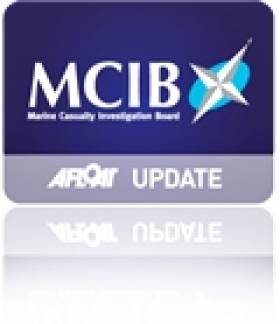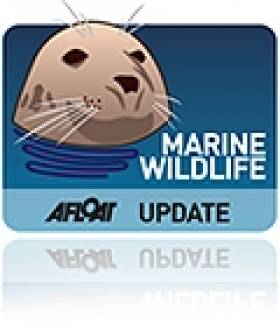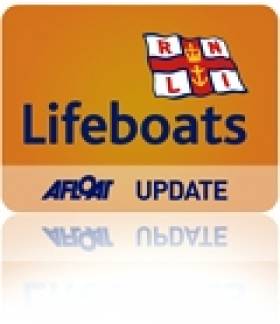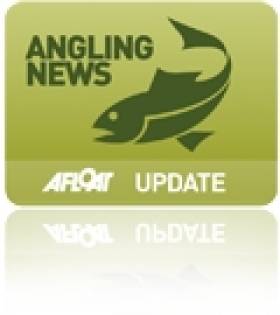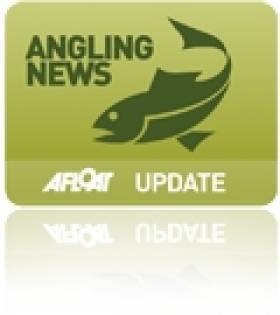Displaying items by tag: Mayo
Neglect of Safety Procedures Led To Leg Injury on Fishing Vessel - MCIB
#MCIB - The dangers of performing maintenance tasks on boats while machinery is running have been highlighted in the official investigation into an accident on a fishing vessel off Erris Head in Co Mayo last year.
The skipper of the MFV James Collins was seriously injured when his leg was caught in the vessel's propeller shaft while attempting to clear debris from the bilge pump on the morning of 20 April 2012.
Jonathan O'Donnell, aged 26 at the time, suffered significant soft tissue damage to his left leg and broke his trivia, fibia and ankle in the incident. Luckily the leg did not require amputation and he is expected to make a full recovery.
The report into the incident by the Marine Casualty Investigation Board (MCIB) found that the vessel's bilge pump was located in the hold adjacent to the propeller shaft, with access to both prevented by the same covering boards.
When O'Donnell responded to a persistent bilge alarm, he did not put the engine on stop or into neutral and the propeller shaft remained turning when he removed the covering boards to access the pump.
As he put his foot into the bilge beside the shaft in order to reach down and clear debris, his waterproof leggings were caught by the coupling on the shaft and his leg was round around it twice.
The MCIB noted the quick actions of the vessel's crew and the prompt attendance of RNLI lifeboat and Irish Coast Guard helicopter crews as instrumental in O'Donnell receiving swift treatment and not losing his leg.
However, the report also pointed to a lack of attention to proper safety precautions on board, nothing that the skipper was "too intent on solving the bilge pump problem" and that he "neglected basic safety procedures" by not stopping all machinery before accessing the bilge as set out in the Code of Practice for Fishing Vessels.
The report concluded that the "ease with which debris could enter the bilge and block the pump suction" was a contributing factor to putting the skipper in his predicament at the time, and also referenced the ease with which loose-fitting clothing like waterproofs can be snagged on turning machinery.
Moreover, the screening of the propeller shaft by covering boards also used to access the bilge pump did not present adequate protection "enabling it to be easily exposed and present a hazard".
The MCIB recommends that the Code of Practice be amended to highlight the danger of accessing the bilge area when shafts are rotating, and to include assessment of sole boards in fish holds to prevent debris passing through to the bilge tank. The complete report is available to download below.
Recent Dolphin, Whale Strandings 'Very Unusual' Says IWDG
#MarineWildlife - The Irish Whale and Dolphin Group (IWDG) has described as "very unusual" a mass stranding of common dolphins on Achill Island last week - which was followed this week by the remains of cetaceans washed up in Kerry.
At least eight common dolphins were found dead on Keel Beach, Keem Beach and Dookinella on the Co Mayo island at the end of January.
And The Irish Times reports that two pilot whales and an "otherwise healthy" dolphin were found washed up at Cuas Croom near Cahirciveen in the last few days.
Commenting on the former incident, IWDG stranding officer Mick O'Connell said: "While there are occasionally live strandings involving groups of dolphins, it is very unusual in this country to see this number of dead dolphins washed ashore over a 10km area."
Strandings of deceased dolphins have also been reported in Donegal, and the IWDG's Simon Berrow suggests that the recent severe weather experienced around Ireland's coast may be a factor.
Lifeboat Crews Tow Vessel From Rocks Off Waterford
#Lifeboats - TheJournal.ie reports that RNLI lifeboat crews from Dunmore East and Fethard rescued two fishermen from their vessel off the Waterford coast yesterday (14 January 2013).
Rescuers sped to the scene after the 10-metre fishing boat got into difficulty and grounded close to the shore north of Loftus Hall.
Despite the receding tide, the lifeboats managed to tow the vessel carefully off the rocks "without any major damage", according to a spokesperson. The two crew were uninjured in the incident.
It marked the third major call-out in a week off the Waterford coast - following a similar rescue effort last Tuesday, and just days after the tragic loss of a local fisherman on Thursday morning on the sixth anniversary of the sinking of Dunmore East trawler the Pere Charles.
Meanwhile, on Sunday afternoon volunteers with Achill Island RNLI went to the assistance of an injured fisherman off the Mayo coast.
The lifeboat station received the distress call around noon to go to the assistance of a fishing party north of Clare Island, where the crew removed a man from the vessel who had suffered an eye injury from a fishing hook.
He was subsequently transported on the lifeboat to Kildavnet, where a local doctor examined his injury before referring him to Castlebar General Hospital for further attention.
Achill Island Attracts Kitesurfers The World Over
#Kitesurfing - “There’s loads of special places in the world, but none of them are Achill,” says kitesurfing instructor Francois Colussi. “There’s something magical here.”
And if this article from TNT Magazine is anything to go by, you'll be sure to agree.
The writer recently spent a short break on the weather-worn but ruggedly beautiful island in Co Mayo that has in recent years become a winter haven for kitesurfers the world over - drawn to the winds and waves that made it the perfect choice to host the Aer Lingus Kite Surf Pro in October.
Those are the same qualities that brought in Frenchman Colussi, who has since turned a former local pub near Keel beach into kitesurfing school Pure Magic.
Indeed, you don’t have to be a professional to kitesurf in Keel. “It’s one of the most extreme sports, but the most accessible. It’s much easier that surfing or windsurfing. You can learn in a weekend,” Colussi tells TNT. “You don’t need huge upper body strength – you’re powered by the wind.”
Even so, at this time of year it's a place for the hardier souls, as Welsh world champ Kirsty Jones describes: “The ocean is pure, Atlantic water. You feel a slap in the face like – Yes! I’m alive!”
TNT Magazine has more on the story HERE.
Marine Notice: Rock Installation Works Along Corrib Pipeline
#MARINE WARNING - The Department of Transport, Tourism and Sport (DTTAS) has been advised that subsea rock installation works will shortly commence along a pipeline route from the Corrib Gas Field in Broad Haven Bay off Co Mayo.
Works will commence in the middle of this month (October 2012) and are expected to be completed in 6-10 days. The operation will be carried out by the vessel Tertnes (Call sign PGAN). All vessels in the vicinity are requested to keep clear of the works as these works progress along the pipeline route and to comply with requests from work vessel.
Furthermore, all vessels are requested to monitor and comply with the Radio Navigational Warnings that will be broadcast for the duration of the works. All vessels involved in the operations will be listening on VHF Channel 16 throughout the project. All vessels are required to comply fully with the International Regulations for the Prevention of Collisions at Sea and to manoeuvre their vessels accordingly.
The attention of all is also drawn to Marine Notice No 17 of 2007, which gives general advice in relation to the activities of vessels engaged in survey work for hydrographic, seismic, fishing research and underwater operations.
Full details of co-ordinates for the current works are included in Marine Notice No 57 of 2012, a PDF of which is available to read or download HERE.
Mayo Angling Ups and Downs as Season Draws to Close
#ANGLING - The going is tough in the last weeks of this year's angling season on Lough Mask, as Mayo Today reports.
Though anglers are still out in good numbers despite the shortening days and drop in temperature, catch numbers are way down on the angling bonanza that marked the beginning of a season that also produced a record-breaking monster trout on nearby Lough Corrib.
The best fishing was seen at the Vintners Federation of Ireland contest on the lough two weeks ago, where the prize-winning catch was a total of seven trout for 4.21kg.
Meanwhile, Celebrity World Cup champ Mick Dunne won the Molloy Cup catch-and-release contest with his catch of five trout measuring 157cm in total.
Elsewhere in Mayo, the River Moy has been more productive, with 199 salmon reported in the seven days preceding 19 September, and Lough Conn and Lough Beltra anglers have also reported some good fishing.
The news makes up for the "relative quiet" on the Newport Rover, and the significant decrease in catches on the Ballisodare Fishery.
Marine Notice: Rock Placements Off Co Dublin & Buoy Deployments Off West Cast
#MARINE WARNING - The latest Marine Notices from the Department of Transport, Tourism and Sport (DTTAS) advise mariners to keep a look-out for rock placement off north Co Dublin and buoy placements off Co Mayo and Co Clare.
Operations were due to commence on Saturday 8 September at North Beach in Rush, Co Dublin for the placement of rocks offshore and in the Irish Sea for a period of 10-12 days weather permitting.
The works are being undertaken by DPFPV Tideway Rollingstone (call sign PHYR) and DPFPV Stornes (call sign PCKX) at various locations detailed in Marine Notice No 49 of 2012, a PDF of which is available to read or download HERE.
These vessels are operating on a 24-hour basis and will display appropriate days shapes and lights. They are also transmitting an AIS signal and will keep a listening watch on VHF Channel 16 for the duration of the works, which involve the deployment of survey ROVs and fall pipe that will restrict the vessels' movements. All mariners are instructed to give a wide berth.
Meanwhile off the west coast, ESB International has deployed two Waveroder buoys as positions near Achill Island in Co Mayo and Doonbeg in Co Clare.
The Achill buoy will be operational for a minumum of three months from now, while the Killard buoy will be operational for a minimum of 10 months having been recently relocated. Both are spherical and yellow in colour. All vessels are requested to give the buoys a wide berth.
Full details of their positions are included in Marine Notice No 50 of 2012, a PDF of which is available to read or download HERE.
Corrib Pipeline Tunnel Machine Removed from Mayo Road
#COASTAL NOTES - A tunnel boring machine destined for work on the Corrib Gas Field project that became stuck at a country crossroads in Co Mayo for much of last week has been removed, as The Irish Times reports.
Shell E&P Ireland apologised to the local community and any road users "who were inconvenienced by this incident" after the truck carrying the giant machine jack-knifed at the isolated road junction on Tuesday 31 July.
The truck was one of four headed to the Sruwaddacon estuary in north Mayo for construction work on what will be the longest raw gas undersea tunnel in Western Europe, used to link the Corrib pipeline to the on-shore refinery at Bellanaboy.
It was finally removed from the crossroads on Friday 3 August.
A spokesman for Rossport Solidarity Camp added that veteran anti-Corrib campaigner Maura Harrington was arrested at one of the Garda checkpoints around the stricken vehicle some 10km away at Bangor Erris.
As previously reported on Afloat.ie, the controversial gas field project has come under much criticism from locals, activist groups and political parties for various issues.
In March last year, former Minister for Energy Pat Carey was rebuked for granting key consents for the Corrib gas pipeline on the day of the general election, despite planning only being approved by An Bord Pleanala with 58 conditions related to the construction and management of the 8.3km pipeline.
Earlier this summer the Irish Whale and Dolphin Group (IWDG) claimed the Department of Energy could be in breach of the EU habitats directive for licencing a seismic survey related to the project without providing adequate protection for marine wildlife.
And in June a Scandinavian economist who met residents in north Mayo told The Irish Times that the Norwegian people have "no idea of what's being done in their name" via the role of state oil firm Statoil in the Corrib Gas Field.
'Extraordinary' Salmon Angling on the River Moy
#ANGLING - Mayo Today reports an extraordinary week of angling on the River Moy, with more than 800 salmon caught.
The best sport on the river was on the East Mayo Anglers' water, where an impressive 179 salmon were snagged on worm, spinner and fly.
The fly catch was particularly good, with visiting anglers Michael O'Kane and John McGinn landing fish of more than 10lbs each.
It marked a second week of great fishing in the region prompted by the persistent rains since June, with the previous week's total nearing 700 on the River Moy alone - the best possible welcome for the visit by Canadian Ambassador to Ireland (and keen Atlantic salmon fly fisherman) Loyola Hearn.
Meanwhile, on the nearby Ballisadore River the fishing was almost as good, with 225 salmon caught during the week.
Topping the catch on that short stretch of water is surely the 15lb monster salmon landed by fishery manager Dermot Glennon taken with shrimp bait.
The situation is very good news in a summer that's seen some concern over salmon stocks in Ireland's rivers.
As reported on Afloat.ie just last month, it was annonced that voluntary conservation measures were being put in place on the Foyle system for the current angling season in response to a "worrying fall" in wild salmon numbers.
Mayo Lakes and Rivers Provide for an Angling Bonanza
#ANGLING - Despite the Nor'easterly winds and rain in recent days, anglers on Co Mayo's lakes and rivers have reported good fishing, as Mayo Today reports.
Saturday 28 April was the day for the Trout Federation of Ireland's Connacht Cup on Lough Mask, which saw an impressive count of 149 trout caught by 31 anglers from seven different clubs.
Eugene Nolan of Annaghdown took the top spot with 18 trout, five more than second place finisher Martin Feerick of Partry. Third place was taken by Aidan Hodgins of Loughrea, which also took the overall team title.
Meanwhile, the River Moy had its best week of the salmon season so far, with 70 fish caught throughout the system.
Foxford Salmon Anglers member Joe Cassidy landed an enormous 16lb salmon upstream of Foxford, one of a number of catches in various parts that broke the 10lb mark.
And with water levels good thanks to the recent heavy rains, expectations have been raised for an even better catch this week.





























